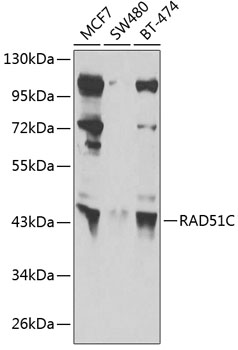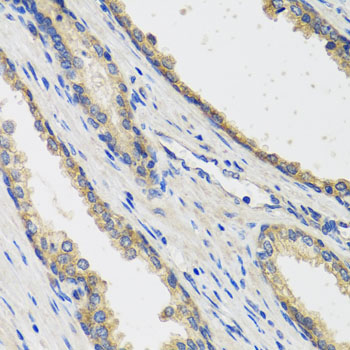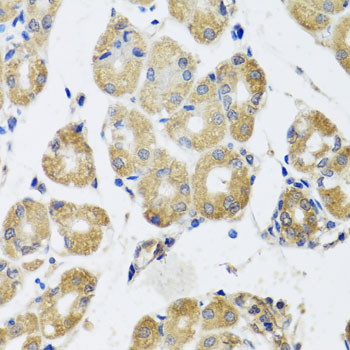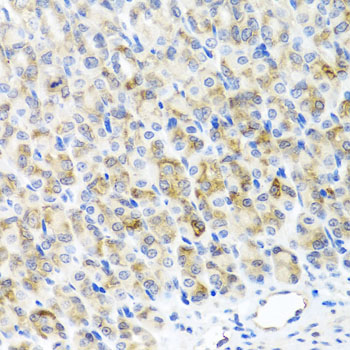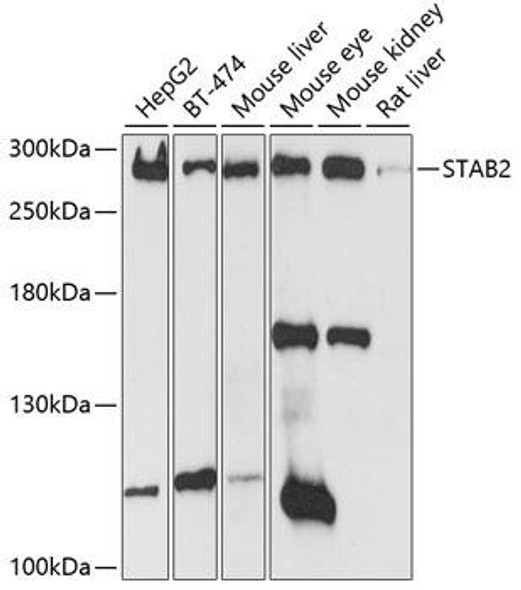Anti-RAD51C Antibody (CAB6961)
- SKU:
- CAB6961
- Product type:
- Antibody
- Reactivity:
- Human
- Mouse
- Host Species:
- Rabbit
- Isotype:
- IgG
- Antibody Type:
- Polyclonal Antibody
- Research Area:
- Epigenetics and Nuclear Signaling
Description
| Antibody Name: | Anti-RAD51C Antibody |
| Antibody SKU: | CAB6961 |
| Antibody Size: | 20uL, 50uL, 100uL |
| Application: | WB IHC |
| Reactivity: | Human, Mouse |
| Host Species: | Rabbit |
| Immunogen: | Recombinant fusion protein containing a sequence corresponding to amino acids 1-135 of human RAD51C (NP_002867.1). |
| Application: | WB IHC |
| Recommended Dilution: | WB 1:500 - 1:2000 IHC 1:50 - 1:100 |
| Reactivity: | Human, Mouse |
| Positive Samples: | MCF7, SW480, BT-474 |
| Immunogen: | Recombinant fusion protein containing a sequence corresponding to amino acids 1-135 of human RAD51C (NP_002867.1). |
| Purification Method: | Affinity purification |
| Storage Buffer: | Store at -20°C. Avoid freeze / thaw cycles. Buffer: PBS with 0.02% sodium azide, 50% glycerol, pH7.3. |
| Isotype: | IgG |
| Sequence: | MRGK TFRF EMQR DLVS FPLS PAVR VKLV SAGF QTAE ELLE VKPS ELSK EVGI SKAE ALET LQII RREC LTNK PRYA GTSE SHKK CTAL ELLE QEHT QGFI ITFC SALD DILG GGVP LMKT TEIC GAPG VGKT QLW |
| Gene ID: | 5889 |
| Uniprot: | O43502 |
| Cellular Location: | Cytoplasm, Mitochondrion, Nucleus, perinuclear region |
| Calculated MW: | 14kDa/42kDa |
| Observed MW: | 42kDa |
| Synonyms: | RAD51C, BROVCA3, FANCO, R51H3, RAD51L2 |
| Background: | This gene is a member of the RAD51 family. RAD51 family members are highly similar to bacterial RecA and Saccharomyces cerevisiae Rad51 and are known to be involved in the homologous recombination and repair of DNA. This protein can interact with other RAD51 paralogs and is reported to be important for Holliday junction resolution. Mutations in this gene are associated with Fanconi anemia-like syndrome. This gene is one of four localized to a region of chromosome 17q23 where amplification occurs frequently in breast tumors. Overexpression of the four genes during amplification has been observed and suggests a possible role in tumor progression. Alternative splicing results in multiple transcript variants. |
| UniProt Protein Function: | RAD51C: Essential for the homologous recombination (HR) pathway of DNA repair. Involved in the homologous recombination repair (HRR) pathway of double-stranded DNA breaks arising during DNA replication or induced by DNA-damaging agents. The RAD51B-RAD51C dimer exhibits single-stranded DNA-dependent ATPase activity. The BCDX2 complex binds single-stranded DNA, single-stranded gaps in duplex DNA and specifically to nicks in duplex DNA. Participates in branch migration and Holliday junction resolution and thus is important for processing HR intermediates late in the DNA repair process. Also has an early function in DNA repair in facilitating phosphorylation of the checkpoint kinase CHEK2 and thereby transduction of the damage signal, leading to cell cycle arrest and HR activation. Protects RAD51 from ubiquitin-mediated degradation that is enhanced following DNA damage. Plays a role in regulating mitochondrial DNA copy number under conditions of oxidative stress in the presence of RAD51 and XRCC3. Contributes to DNA cross-link resistance, sister chromatid cohesion and genomic stability. Involved in maintaining centrosome number in mitosis. Defects in RAD51C are the cause of Fanconi anemia complementation group O (FANCO). It is a disorder affecting all bone marrow elements and resulting in anemia, leukopenia and thrombopenia. It is associated with cardiac, renal and limb malformations, dermal pigmentary changes, and a predisposition to the development of malignancies. At the cellular level it is associated with hypersensitivity to DNA-damaging agents, chromosomal instability (increased chromosome breakage) and defective DNA repair. Defects in RAD51C are the cause of familial breast- ovarian cancer type 3 (BROVCA3). It is a condition associated with familial predisposition to cancer of the breast and ovaries. Characteristic features in affected families are an early age of onset of breast cancer (often before age 50), increased chance of bilateral cancers (cancer that develop in both breasts, or both ovaries, independently), frequent occurrence of breast cancer among men, increased incidence of tumors of other specific organs, such as the prostate. Belongs to the RecA family. RAD51 subfamily. 2 isoforms of the human protein are produced by alternative splicing. |
| UniProt Protein Details: | Protein type:DNA repair, damage Chromosomal Location of Human Ortholog: 17q22 Cellular Component: cell junction; cytoplasm; cytosol; intracellular membrane-bound organelle; mitochondrion; nucleoplasm; nucleus; perinuclear region of cytoplasm; replication fork Molecular Function:crossover junction endodeoxyribonuclease activity; DNA binding; DNA-dependent ATPase activity; double-stranded DNA binding; four-way junction DNA binding; protein binding; recombinase activity; single-stranded DNA binding Biological Process: blood coagulation; DNA recombination; DNA repair; DNA synthesis during DNA repair; double-strand break repair via homologous recombination; meiotic DNA recombinase assembly; meiotic recombination; mitotic recombination; response to ionizing radiation; sister chromatid cohesion; strand displacement; strand invasion Disease: Breast-ovarian Cancer, Familial, Susceptibility To, 3; Fanconi Anemia, Complementation Group O; Tracheoesophageal Fistula With Or Without Esophageal Atresia |
| NCBI Summary: | This gene is a member of the RAD51 family. RAD51 family members are highly similar to bacterial RecA and Saccharomyces cerevisiae Rad51 and are known to be involved in the homologous recombination and repair of DNA. This protein can interact with other RAD51 paralogs and is reported to be important for Holliday junction resolution. Mutations in this gene are associated with Fanconi anemia-like syndrome. This gene is one of four localized to a region of chromosome 17q23 where amplification occurs frequently in breast tumors. Overexpression of the four genes during amplification has been observed and suggests a possible role in tumor progression. Alternative splicing results in multiple transcript variants. [provided by RefSeq, Jul 2013] |
| UniProt Code: | O43502 |
| NCBI GenInfo Identifier: | 3914534 |
| NCBI Gene ID: | 5889 |
| NCBI Accession: | O43502.1 |
| UniProt Secondary Accession: | O43502,O43503, Q3B783, |
| UniProt Related Accession: | O43502 |
| Molecular Weight: | 42kDa |
| NCBI Full Name: | DNA repair protein RAD51 homolog 3 |
| NCBI Synonym Full Names: | RAD51 paralog C |
| NCBI Official Symbol: | RAD51C |
| NCBI Official Synonym Symbols: | FANCO; R51H3; BROVCA3; RAD51L2 |
| NCBI Protein Information: | DNA repair protein RAD51 homolog 3 |
| UniProt Protein Name: | DNA repair protein RAD51 homolog 3 |
| UniProt Synonym Protein Names: | RAD51 homolog C; RAD51-like protein 2 |
| Protein Family: | DNA repair protein |
| UniProt Gene Name: | RAD51C |


